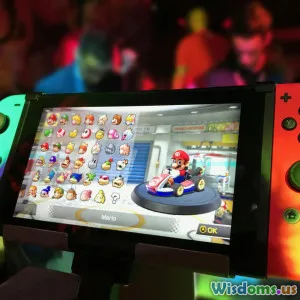
Why Retro Consoles Still Outsell Modern Gaming Tech
15 min read Explore why retro consoles continue to outsell modern gaming tech, highlighting nostalgia, affordability, and timeless gameplay. (0 Reviews)
Why Retro Consoles Still Outsell Modern Gaming Tech
It’s a rainy Saturday afternoon. Rather than firing up the latest 4K console, a surprising number of gamers find themselves dusting off an old Nintendo 64 or Sega Genesis. From auction sites to boutique retro stores, the demand for classic gaming hardware isn’t just surviving—it’s thriving. In a digital age saturated with hyper-realistic graphics and online platforms, the consistent popularity—and sometimes outselling—of retro consoles raises a compelling question: Why does old school win?
Let’s delve into the nuanced reasons behind the resilience and renewed popularity of retro consoles in a modern gaming universe that constantly touts “next gen.”
The Nostalgia Factor: More Than Just Memories

There’s a unique warmth to the chirpy theme music of Super Mario Bros. and the chunky cartridges of the SNES or PlayStation 1 discs. For many, these consoles are time machines, not just entertainment devices. Nostalgia isn’t mere sentimentality; it's an emotional anchor, reconnecting people with simpler times before cloud saves and downloadable content (DLC).
Emotional Value Translates to Sales
A 2021 survey by Statista revealed that over 60% of retro game buyers listed “reliving childhood memories” as their primary motivation. Notably, Nintendo's NES Classic and Sony's PlayStation Classic leveraged this, with their launches selling out within hours worldwide. The re-release of the NES Classic in 2016 saw it outsell PlayStation 4 in the U.S. for July 2018, a feat few expected.
Family Bridging and Shared Experiences
Retro consoles often connect generations. Parents introduce classic systems like the Sega Genesis to their children, facilitating a family gaming night that’s often simpler and more inclusive than competitive online fare. This intergenerational appeal keeps demand strong, fueling resurgent interest and steady sales in the retro market.
Simplicity and Accessibility: Pick Up and Play

Modern gaming pushes boundaries, but that complexity can be intimidating. Compared to sprawling open-world titles demanding dozens of hours and steep learning curves, vintage titles offer instant engagement. Boot up a Super Mario Bros. console, and you’re in the game in seconds—no login screens, mandatory updates, or convoluted menus.
Ease of Use Attracts Casual Gamers
The tactile satisfaction of plugging in a cartridge and immediately beginning to play is a core part of the retro experience. For newcomers and casual gamers, old consoles provide straightforward fun without the friction of modern system requirements or steep gameplay tutorials.
Portable and Durable
Many retro consoles, especially handhelds like the Game Boy, are durable, portable, and require no internet connection. For travelers, collectors, and gamers on-the-go, this translates to ongoing sales and popularity. The legendary ‘brick’ Game Boy has even survived being bombed in the Gulf War—evidence of their hardware resilience, a selling point modern consoles often lack.
Affordability and the Collector’s Market

Contrary to popular belief, retro gaming isn’t always cheaper. Original hardware, limited editions, and rare cartridges fetch high prices at auctions. Yet, for many other models, retro consoles present an affordable alternative to multi-hundred-dollar new releases and microtransaction-filled games.
Creative Economies and Accessible Pricing
- Local Game Shops & Flea Markets: Many local retailers and markets specialize in secondhand and refurbished systems at attractive prices. A working PlayStation 2 or Super Nintendo can often be picked up for under $100, including games.
- Game Libraries: Retro consoles typically feature game libraries numbering in the hundreds or thousands—games often more accessible and less “locked” than their modern digital-only counterparts.
Asset Value and Investment
Rarity keeps the collector’s market thriving. Titles like EarthBound for SNES and consoles like the Neo Geo AES can command thousands of dollars. Auction houses and online marketplaces such as eBay or Heritage Auctions have seen sustained growth in retro gaming memorabilia, positioning them as collectibles with appreciating value, a rarity for most modern technology.
Unique Gameplay and Creative Design
d![]()
What retro consoles lack in graphical fidelity, they typically make up for with inventive gameplay and charm. Limitations in hardware drove developers to think creatively, leading to innovative game mechanics and enduring franchises.
Iconic Game Design That Endures
How games like Tetris, Super Mario Bros., and Pac-Man remain playable decades later speaks to their intrinsic design elegance. Many indie games today self-consciously echo the mechanics and aesthetics of this golden era, such as “Shovel Knight” or “Celeste,” confirming the influence and ongoing relevance.
Arcade-Perfect Ports
Retro hardware also brought the arcade home, with near-perfect ports of hits like Street Fighter II and Sonic the Hedgehog. For enthusiasts, owning the original console is the authentic way to recapture quarters-and-all experiences.
Physical Ownership in an Ephemeral Age

In an era where games can disappear overnight, thanks to digital licensing or delisting, retro consoles represent very real, tangible ownership. There’s inherent satisfaction in unboxing an original console, inserting a cartridge, and displaying a physical game collection.
Digital Disappearance
High-profile digital game removals—such as PT on PlayStation or games lost to defunct online stores—expose the fragility of modern libraries. Buyers flock to retro consoles as a form of gaming preservation and security. With no day-one patches or remote kill-switches, your SNES game is always as playable as the day it was bought.
The Joy of Collecting
Whether it’s covering a shelf in classic Zelda boxes or showing off a fleet of unique controllers, retro console collectors find pride in curating and displaying their treasures. This tactile element cannot be replicated with digital downloads or streaming-only games, helping to fuel ongoing sales of physical hardware.
Community and the Emergence of the Retro Scene

Retro consoles enjoy vibrant communities, from passionate YouTubers to bustling conventions. Live speedrunning events, such as Games Done Quick, regularly feature classic Nintendo and Sega consoles, drawing millions of viewers and reinforcing relevancy and public interest.
Tournaments, Events, and Clubs
Retro gaming tournaments, like the Classic Tetris World Championship, keep games such as Tetris on the NES not just relevant but crowd-pullers. Local retro gaming nights and fan clubs offer welcoming inroads for new fans, creating positive feedback loops for hardware and software sales.
Online Forums and Tutorial Sharing
Dynamic communities on platforms like Reddit’s /r/GameCollecting and numerous Discord servers share repair tutorials, hardware modifications, and buying guides for retro systems. This enduring ecosystem aids both beginners and experts, facilitating continued hardware circulation and raising demand for genuine components—even outselling new releases in some cases.
Modding and Homebrew: Expanding the Retro Frontier

Enthusiasts aren’t satisfied with merely reliving the past—they actively make it better. Modders restore yellowed plastics, install modern HDMI ports in NES consoles, and engineer flash cartridges to load ROMs legally. New indie “homebrew” games for systems like Game Boy or Genesis sustain fan bases and hardware value long after official support has ended.
Modern Functionality for Old Hardware
- Examples: The Analogue Super Nt and Mega Sg recreate the SNES and Genesis with HDMI compatibility, making classic libraries playable on contemporary TVs.
- ROM Hacking & Indie Development: Titles like Battle Kid: Fortress of Peril for NES highlight just how far enthusiasts push limitations, creating not just nostalgia-bait, but genuinely compelling new experiences.
Sustainability and Repairability
Modern hardware is notoriously hard to self-repair, thanks to proprietary parts. Amateur retro console restorers and tinkerers swap parts, share guides, and even 3D print replacement shells for decades-old systems. This community-driven support outpaces most manufacturer service lifespans, keeping retro devices usable and in high demand.
Limited Edition Releases and New Marketplace Dynamics

Manufacturers haven't ignored the enduring appetite for legacy hardware. Nintendo’s microconsoles (NES Classic, SNES Classic), Sony’s PlayStation Classic, and Sega’s Genesis Mini sparked frenzied demand, not only among nostalgic fans but also investors and younger players.
Immediate Sellouts
Nintendo sold over 3.6 million NES Classic units even as production couldn't match initial demand. E-commerce reflects this enthusiasm: in 2022, the NES Classic outsold the Xbox One X and PlayStation 5 on Amazon Japan for several weeks during the holiday season. Many buyers double as collectors, rapidly depleting stock and keeping resale prices high.
Boutique Console Makers and Indie Retailers
Beyond big manufacturers, boutique companies like Analogue and Polymega offer “new” retro consoles with modern features (HDMI, SD Card support) yet true to the original experience. Crowdfunding campaigns for limited runs often sell out in hours, reflecting pent-up demand not addressed by mainstream console cycles.
A Timeless Appeal—and the Road Ahead

Retro consoles are not merely tech relics— they fill cultural, emotional, and social niches untouched by even the most advanced new hardware. Modern devices battle for attention with streaming, VR, and esports, but retro consoles offer a different value: simplicity, creativity, and personal connection.
Gamers today are as likely to be preservationists, collectors, or modders as they are next-gen aficionados. As digital distribution, cloud gaming, and hardware cycles accelerate, a growing cohort clings to gaming’s tactile past and authentic roots. The ongoing popularity—and in many seasons, superior sales—of retro consoles isn’t a fluke. It’s a testament to their timeless ingenuity, cross-generational resonance, and the refuge of fun they provide in a continually evolving digital landscape.
Whether you're chasing a nostalgic high or exploring a world of play earlier generations called their own, retro consoles won’t fade quietly—they will continue outselling, outlasting, and out-charming the rush of what’s new.
Rate the Post
User Reviews
Popular Posts


















